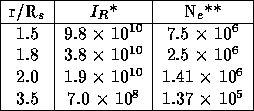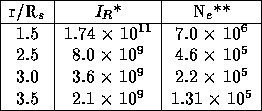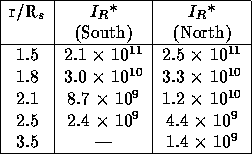



Next: Measured HI Ly-
Up: Estimates of Line
Previous: Calculated Line Intensities
HI Ly- intensities were measured in polar regions during
sounding rocket flights in 1979, 1980, and
in 1982. The instrument used for the
observations was an ultraviolet coronagraph (Kohl, Reeves
and Kirkham, 1978). In addition, the
Ultraviolet Coronal Spectrometer on Spartan 201 measured
HI Ly-
intensities were measured in polar regions during
sounding rocket flights in 1979, 1980, and
in 1982. The instrument used for the
observations was an ultraviolet coronagraph (Kohl, Reeves
and Kirkham, 1978). In addition, the
Ultraviolet Coronal Spectrometer on Spartan 201 measured
HI Ly- intensities
and line profiles in the north and south polar coronal holes in
April 1993.
intensities
and line profiles in the north and south polar coronal holes in
April 1993.
Intensities measured in a polar region of the corona observed in 1979 near the time of solar
maximum (Withbroe, Kohl and Weiser, 1986) are
provided in Table 6. Effects of the Ly- geocorona
have been removed from the
data. The estimated electron
densities are also listed.
Outflow velocities were believed to be subsonic out to 4 solar radii.
geocorona
have been removed from the
data. The estimated electron
densities are also listed.
Outflow velocities were believed to be subsonic out to 4 solar radii.
Table 6.
Measured HI Ly- Intensities in a polar region observed in 1979.
Intensities in a polar region observed in 1979.

* (ph s cm
cm sr
sr )
)
** (cm )
Intensities for a polar region observed in 1980
are provided in Table 7 (Withbroe, Kohl, Weiser and
Munro, 1986). Effects of the Ly-
)
Intensities for a polar region observed in 1980
are provided in Table 7 (Withbroe, Kohl, Weiser and
Munro, 1986). Effects of the Ly- geocorona
have been removed from the data. The estimated electron
densities are also listed. The outflow velocity appeared to be subsonic out to 4 solar
radii.
geocorona
have been removed from the data. The estimated electron
densities are also listed. The outflow velocity appeared to be subsonic out to 4 solar
radii.
Table 7.
Measured HI Ly- Intensities in a polar region observed in 1980.
Intensities in a polar region observed in 1980.

* (ph s cm
cm sr
sr )
)
** (cm )
)
Figure 3.5. a--b Total intensities of the lines of the
O VI resonance doublet simulated for the equatorial coronal hole at several
values of heliocentric distance, considering the contribution of the
coronal hole alone (filled squares), or also the contribution of the
surrounding quiet corona, either expanding (stars) or static (crosses).
c--d As above, but for the polar coronal hole. (From Spadaro and
Ventura 1993).
Intensities for the polar coronal hole observed in 1982 are provided
in Table 8 (Strachan, Kohl,
Weiser, Withbroe and Munro, 1993). Polar
maps derived from Mark III K-coronagraph observations
indicated that the coronal hole covered a
large portion of the northern hemisphere. The effects
of the Ly- geocorona have been removed from the
data. Electron densities derived from a white
light coronagraph, which was a companion to the rocket
ultraviolet coronagraph, are also provided.
A Doppler dimming analysis suggested that the
bulk outflow velocity was about 217 km/s at 2 solar
radii. The Doppler dimming and the low
densities accounted for the low Ly-
geocorona have been removed from the
data. Electron densities derived from a white
light coronagraph, which was a companion to the rocket
ultraviolet coronagraph, are also provided.
A Doppler dimming analysis suggested that the
bulk outflow velocity was about 217 km/s at 2 solar
radii. The Doppler dimming and the low
densities accounted for the low Ly- intensities.
intensities.
Table 8.
Measured HI Ly- Intensities in a polar region observed in 1982.
Intensities in a polar region observed in 1982.

* (ph s cm
cm sr
sr )
)
** (cm )
Intensities for the north and south polar
holes observed during the Spartan 201-1 mission in
1993 are given in Table 9. The Spartan
white light coronagraph determined that the north polar region had
a relatively large number of polar
plumes extending out to at least 3.5 solar radii. The plumes
were also observed by the Mark III
instrument and, in x-rays, by the Yohkoh satellite. The north
coronal hole appeared to be relatively small, and its
base appeared to be primarily behind the
limb. The south polar hole was much larger, and
the white light data showed evidence of polar
plumes in the south hole. The effects of the
geocorona have been removed from the data.
)
Intensities for the north and south polar
holes observed during the Spartan 201-1 mission in
1993 are given in Table 9. The Spartan
white light coronagraph determined that the north polar region had
a relatively large number of polar
plumes extending out to at least 3.5 solar radii. The plumes
were also observed by the Mark III
instrument and, in x-rays, by the Yohkoh satellite. The north
coronal hole appeared to be relatively small, and its
base appeared to be primarily behind the
limb. The south polar hole was much larger, and
the white light data showed evidence of polar
plumes in the south hole. The effects of the
geocorona have been removed from the data.
Table 9.
Measured HI Ly- Intensities in north and south polar regions observed in 1993.
Intensities in north and south polar regions observed in 1993.

* (ph s cm
cm sr
sr )
Comparison of the theoretical intensities provided in
Tables 3 and 4 to the experimental results
given in Tables 6-8 provides an idea of the
variation in intensity to be expected from structure
to structure. Interestingly, the Spartan observations are
similar to the model values in Table 3.
In contrast, the 1982 intensities are considerably lower
than Table 3. It appears that Doppler
dimming has significantly decreased the intensity in the 1982
coronal hole. The polar region
observed in 1980 had considerably higher intensities
than in Table 3. This appears to be due to
the higher electron density. The 1979 polar
hole was similar in intensity to both the calculated
values and the Spartan 201-1 observations except at 1.5 solar radii.
)
Comparison of the theoretical intensities provided in
Tables 3 and 4 to the experimental results
given in Tables 6-8 provides an idea of the
variation in intensity to be expected from structure
to structure. Interestingly, the Spartan observations are
similar to the model values in Table 3.
In contrast, the 1982 intensities are considerably lower
than Table 3. It appears that Doppler
dimming has significantly decreased the intensity in the 1982
coronal hole. The polar region
observed in 1980 had considerably higher intensities
than in Table 3. This appears to be due to
the higher electron density. The 1979 polar
hole was similar in intensity to both the calculated
values and the Spartan 201-1 observations except at 1.5 solar radii.




Next: Measured HI Ly-
Up: Estimates of Line
Previous: Calculated Line Intensities
Peter Smith
Fri Jan 17 12:11:15 EST 1997
 intensities were measured in polar regions during
sounding rocket flights in 1979, 1980, and
in 1982. The instrument used for the
observations was an ultraviolet coronagraph (Kohl, Reeves
and Kirkham, 1978). In addition, the
Ultraviolet Coronal Spectrometer on Spartan 201 measured
HI Ly-
intensities were measured in polar regions during
sounding rocket flights in 1979, 1980, and
in 1982. The instrument used for the
observations was an ultraviolet coronagraph (Kohl, Reeves
and Kirkham, 1978). In addition, the
Ultraviolet Coronal Spectrometer on Spartan 201 measured
HI Ly- intensities
and line profiles in the north and south polar coronal holes in
April 1993.
intensities
and line profiles in the north and south polar coronal holes in
April 1993.




 geocorona
have been removed from the
data. The estimated electron
densities are also listed.
Outflow velocities were believed to be subsonic out to 4 solar radii.
geocorona
have been removed from the
data. The estimated electron
densities are also listed.
Outflow velocities were believed to be subsonic out to 4 solar radii.
 Intensities in a polar region observed in 1979.
Intensities in a polar region observed in 1979.

 cm
cm sr
sr )
)
 )
Intensities for a polar region observed in 1980
are provided in Table 7 (Withbroe, Kohl, Weiser and
Munro, 1986). Effects of the Ly-
)
Intensities for a polar region observed in 1980
are provided in Table 7 (Withbroe, Kohl, Weiser and
Munro, 1986). Effects of the Ly- geocorona
have been removed from the data. The estimated electron
densities are also listed. The outflow velocity appeared to be subsonic out to 4 solar
radii.
geocorona
have been removed from the data. The estimated electron
densities are also listed. The outflow velocity appeared to be subsonic out to 4 solar
radii.
 Intensities in a polar region observed in 1980.
Intensities in a polar region observed in 1980.

 cm
cm sr
sr )
)
 )
)
 geocorona have been removed from the
data. Electron densities derived from a white
light coronagraph, which was a companion to the rocket
ultraviolet coronagraph, are also provided.
A Doppler dimming analysis suggested that the
bulk outflow velocity was about 217 km/s at 2 solar
radii. The Doppler dimming and the low
densities accounted for the low Ly-
geocorona have been removed from the
data. Electron densities derived from a white
light coronagraph, which was a companion to the rocket
ultraviolet coronagraph, are also provided.
A Doppler dimming analysis suggested that the
bulk outflow velocity was about 217 km/s at 2 solar
radii. The Doppler dimming and the low
densities accounted for the low Ly- intensities.
intensities.
 Intensities in a polar region observed in 1982.
Intensities in a polar region observed in 1982.

 cm
cm sr
sr )
)
 )
Intensities for the north and south polar
holes observed during the Spartan 201-1 mission in
1993 are given in Table 9. The Spartan
white light coronagraph determined that the north polar region had
a relatively large number of polar
plumes extending out to at least 3.5 solar radii. The plumes
were also observed by the Mark III
instrument and, in x-rays, by the Yohkoh satellite. The north
coronal hole appeared to be relatively small, and its
base appeared to be primarily behind the
limb. The south polar hole was much larger, and
the white light data showed evidence of polar
plumes in the south hole. The effects of the
geocorona have been removed from the data.
)
Intensities for the north and south polar
holes observed during the Spartan 201-1 mission in
1993 are given in Table 9. The Spartan
white light coronagraph determined that the north polar region had
a relatively large number of polar
plumes extending out to at least 3.5 solar radii. The plumes
were also observed by the Mark III
instrument and, in x-rays, by the Yohkoh satellite. The north
coronal hole appeared to be relatively small, and its
base appeared to be primarily behind the
limb. The south polar hole was much larger, and
the white light data showed evidence of polar
plumes in the south hole. The effects of the
geocorona have been removed from the data.
 Intensities in north and south polar regions observed in 1993.
Intensities in north and south polar regions observed in 1993.

 cm
cm sr
sr )
Comparison of the theoretical intensities provided in
Tables 3 and 4 to the experimental results
given in Tables 6-8 provides an idea of the
variation in intensity to be expected from structure
to structure. Interestingly, the Spartan observations are
similar to the model values in Table 3.
In contrast, the 1982 intensities are considerably lower
than Table 3. It appears that Doppler
dimming has significantly decreased the intensity in the 1982
coronal hole. The polar region
observed in 1980 had considerably higher intensities
than in Table 3. This appears to be due to
the higher electron density. The 1979 polar
hole was similar in intensity to both the calculated
values and the Spartan 201-1 observations except at 1.5 solar radii.
)
Comparison of the theoretical intensities provided in
Tables 3 and 4 to the experimental results
given in Tables 6-8 provides an idea of the
variation in intensity to be expected from structure
to structure. Interestingly, the Spartan observations are
similar to the model values in Table 3.
In contrast, the 1982 intensities are considerably lower
than Table 3. It appears that Doppler
dimming has significantly decreased the intensity in the 1982
coronal hole. The polar region
observed in 1980 had considerably higher intensities
than in Table 3. This appears to be due to
the higher electron density. The 1979 polar
hole was similar in intensity to both the calculated
values and the Spartan 201-1 observations except at 1.5 solar radii.